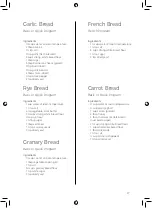
21
The basics of bread making
An understanding of ingredients and their interaction is essential to good bread
making. This short guide will help you understand some of the processes and the
materials used.
Flour
Flour is the essential ingredient. It should be fresh, and stored in cool, dry
conditions, preferably in an airtight jar. Use only bread making flour. General
purpose flours do not contain enough gluten to produce well-structured bread.
Wholemeal wheat flour contains the whole grain. This results in heavier denser
loaves than bread made with white bread flour, and takes longer to rise - use the
Whole Wheat setting for best results.
Flours such as oatmeal are often added to bread flours to make specialty loaves.
Many of these flours contain no gluten so they cannot be used entirely on their
own.
Flours vary - millers all have their own special methods, and age and storage
play their part. Although you should always follow the recipe carefully there are
occasions when you may have to adjust the dough.
You may do this a few minutes into the kneading cycle. Open the Bread Maker lid
and gently touch the dough. It should feel very slightly sticky. If it is sloppy, add a
little flour (½ -1 tablespoon). Allow this to work in and re-check if necessary. If the
dough is too dry, add the same amount of lukewarm water. Re-check if necessary.
As you gain experience, you will get to know the feel of good dough. It should be
soft and smooth with the faintest sticky feel, but should leave no residue when
turned out of the barrel, as in our recipes for doughnuts and other recipes blended
on the Dough program.
The only time you can adjust the quality of the dough is during the kneading cycle.
Once baking commences, do not lift the lid, or the bread may spoil.
Milk
Whole, semi-skimmed or skimmed milk can be used in bread making but it should
always be added lukewarm. Refrigerated milk must be heated to around 27ºC
(80ºF). Never heat milk above 37ºC (98ºF) as this can cause problems with yeast.
Liquid Quantities
Milk can usually be substituted for water in most recipes, but the quantity may
need to be adjusted - usually slightly higher. If dried milk features in the recipe,
leave it out when substituting milk for water.
Flour is absorbent, its texture will vary to some extent with the prevailing
atmospheric conditions. The amount of liquid may have to be adjusted if the
conditions in your kitchen are excessively dry or humid. If there is too much water
in the bread it will not rise properly, even to the point of collapse. Insufficient liquid
will result in a poorly structured, lumpy loaf.
Содержание T11003
Страница 30: ...30 Notes ...
Страница 31: ...31 Notes ...












































